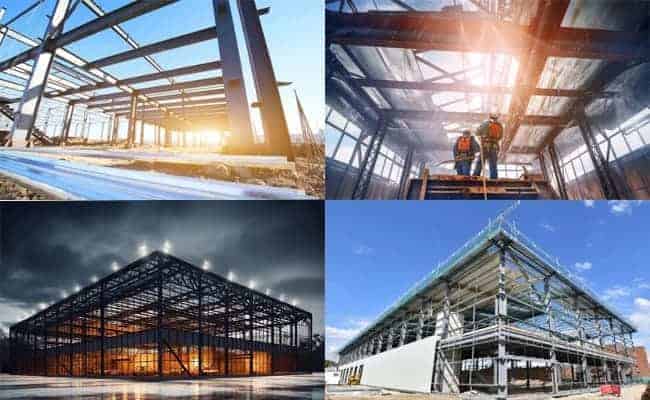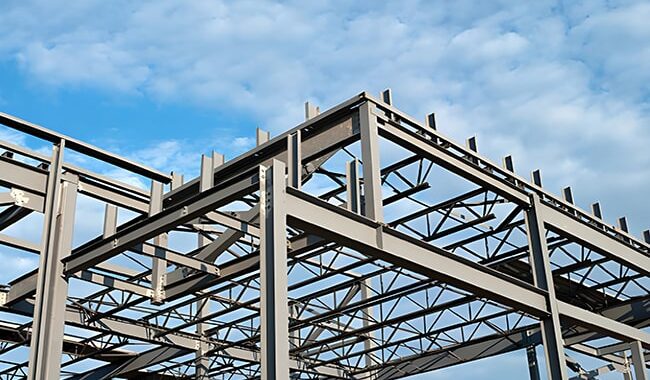A steel frame is a structure made of steel, usually connected by welding, bolting, or riveting steel beams, columns, bracing,…
Steel structure reinforcement refers to measures such as strengthening, partial replacement, or adjusting its internal force for steel structures, components, and related parts that are unreliable or require improved reliability. These steel structure reinforcement measures are intended to make the overall structure meet the safety, applicability, and durability required by the current design standards while meeting the owner’s needs and requirements.

The main reasons for steel structure reinforcement are as follows:
Design or construction defects:
There may be some mistakes in design or construction, such as insufficient weld length, too-long component cuts, etc. These defects will weaken component sections and affect the stability of the structure.
Accidental deformation and damage:
Steel structures may be deformed or dented due to accidental events such as collision, impact, twisting, etc. These deformations will reduce the strength and stability of the member.
Corrosion and erosion:
Long-term exposure to harsh environments, steel structures may be eroded and corroded by chemical substances, resulting in weakened component sections and even corrosive fractures.
Load changes:
Future load changes may not be considered during structural design, such as load increases, code updates, etc., resulting in the original structure being unable to bear new loads and requiring steel structure reinforcement to increase the bearing capacity.
Material quality issues:
Using steel that does not meet the requirements, such as insufficient strength or defects, will reduce the overall performance of the structure.
Natural disasters and accidents:
Natural disasters such as earthquakes, storms, etc., and accidents may cause severe damage to the structure, requiring reinforcement and repair of damaged parts.
Foundational problems:
The subsidence or deformation of the foundation will cause deformation and damage to the entire structure, and the foundation needs to be strengthened to restore the system’s stability.
Mistakes in design, production, and construction:
Mistakes or illegal operations may occur during the structure’s design, production, and construction, resulting in hidden dangers in the system, which need to be repaired through steel structure reinforcement.
Standard Methods for Steel Structure Reinforcement
Changing the calculation diagram, section reinforcement, and prestressed cable method.
Prestressed cable method:
Strengthen the weak parts of the structure by using high-strength cables or improve the overall bearing capacity, stiffness, and stability.
Replacing reinforcement components: When the structure is seriously damaged, or the bearing capacity of the original section is insufficient, it is necessary to remove the parts to be reinforced or updated from the original structure and support or replace them on the ground. This requires setting up temporary supports to ensure that the replaced components are completely unloaded while ensuring the safety of the overall structure.
Change the calculation diagram: Reduce the structure’s internal and peak stress by adding additional supports, adjusting the load distribution, and reducing the internal force level. For statically indeterminate structures, forced displacements can also be introduced to change the stress distribution of the system.
Steel structure reinforcement with load: It is suitable for the case where the stress of the component (or connection) is less than 80% of the design strength of the steel, or the part is not seriously damaged (such as breakage, deformation, warping, etc.). In this case, it may be necessary to take temporary unloading measures for the reinforced members to allow the new reinforced members to bear part of the load. In addition, it is essential to ensure that the regular use of other components will not be affected during the steel structure reinforcement process.
Cross-section reinforcement method:
Steel structure Reinforcement with materials locally or along the entire component length to form an overall structure and jointly bear the force.
Unloading reinforcement: It is suitable for situations where the structure is severely damaged, or the stress state of components and connections is high, and the load needs to be temporarily relieved. For some facilities mainly subjected to dynamic loads (such as crane beams), the dynamic loads can be limited, equivalent to unloading the structure to a certain extent.
When carrying out steel structure reinforcement, detailed structural assessment and analysis are required to determine the specific method and area of support. In addition, relevant building codes and standards must be followed to ensure that the steel structure reinforcement meets the requirements for safety and reliability.
Steel structure accidents and treatment methods:
Material accidents in steel structures
Cause description: Accidents of steel structure materials refer to accidents caused by the fabric. This includes both steel and connecting materials. The main factors that cause steel performance problems are excessive harmful chemical components, metallurgical rolling defects, hardening to reduce plasticity and toughness, stress concentration, and extreme temperatures.
Common factors: Common factors that cause steel structure material accidents include unqualified steel quality, bolt quality problems, substandard welding material quality, improper material selection, unreasonable construction technology, mismatch between base metal and welding material, random mixing or substitution of materials, etc.
Treatment method: The solution includes selecting appropriate materials according to the actual situation, strictly prohibiting using unqualified materials, selecting proper construction techniques, and strictly following the design and relevant specifications for fabrication and installation. In addition, regular inspection and maintenance are required in actual use.
Instability accident of steel structure
The instability concept refers to the range in which a steel structure or component loses its overall stability when it is under load and reaches the limit state of the bearing capacity. Instability can be divided into overall instability, partial instability, equilibrium bifurcation instability, extreme point instability, and jump instability.
Features: The characteristics of instability accidents are that when the structure is damaged due to insufficient tensile strength, large deformation will occur, and when the system is damaged due to inadequate compression stability, the deformation may not be significant, but brittle failure will occur, which is the most dangerous situation.
Preventive measures: To prevent instability accidents, it is necessary to strengthen the design concept of stability, and the production unit should minimize defects; the construction unit should ensure safety during the installation process; the user unit needs to maintain and use the steel structure building usually.
Corrosion accident of steel structure
Corrosion type: Steel structure corrosion is divided into chemical and electrochemical corrosion. The chemical reaction between the steel and the surrounding medium causes chemical pollution. In contrast, the oxidation-reduction reaction between the steel and the surrounding medium causes electrochemical corrosion. Factors that affect decline include humid air, steel surface structure, impurity distribution, stress deformation, and surface smoothness.
Methods of embalming include:
(1) Reasonable building layout to facilitate natural ventilation and reduce the content of harmful substances;
(2) Select low-alloy steel materials containing an appropriate amount of alloy elements, resistant to atmospheric corrosion, and suitable coatings;
(3) Adopt a scheme that is not easy to rust in the selection of structure;
(4) Adopt advanced scientific management and reasonable anti-corrosion measures.
Fire accidents in steel structures
Steel is not easy to burn, but its fire resistance is poor and not resistant to high temperatures. Steel structures are prone to large spans, large spaces, rapid spread, overall solid connectivity, and easy deformation and collapse in fires.
Preventive measures include using fire-resistant coatings, pouring concrete, laying bricks, and other actions to carry out fire-proofing treatment of steel structures. These measures can improve the fire resistance of steel structures to a certain extent and reduce the damage caused by fire.
In short, to ensure the reliability of the steel structure engineering that has been customarily designed and constructed, the construction unit should conduct regular inspections or maintenance of the steel structure during the use phase and entrust a professional organization to conduct reliability appraisal when necessary, to ensure the safety of the steel structure. Safety and durability, and through scientific design and correct construction, the safe use of steel structures is guaranteed.














